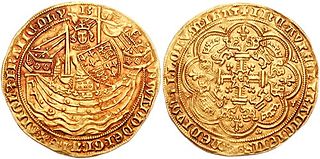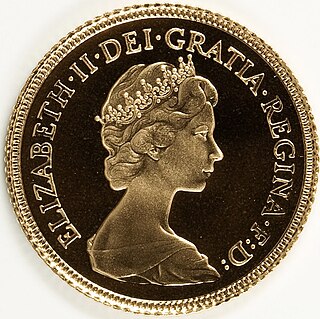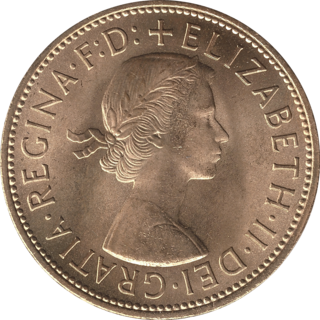
The standard circulating coinage of the United Kingdom, British Crown Dependencies and British Overseas Territories is denominated in pennies and pounds sterling, and ranges in value from one penny sterling to two pounds. Since decimalisation, on 15 February 1971, the pound has been divided into 100 (new) pence. Before decimalisation, twelve pence made a shilling, and twenty shillings made a pound.

The noble was the first English gold coin produced in quantity, introduced during the second coinage (1344–1346) of King Edward III. It was preceded by the gold penny and the florin, minted during the reign of King Henry III and the beginning of the reign of King Edward III; these saw little circulation. The derivatives of the noble, the half noble and quarter noble, on the other hand, were produced in quantity and were very popular.

The penny of Great Britain and the United Kingdom from 1714 to 1901, the period in which the House of Hanover reigned, saw the transformation of the penny from a little-used small silver coin to the bronze piece recognisable to modern-day Britons. All bear the portrait of the monarch on the obverse; copper and bronze pennies have a depiction of Britannia, the female personification of Britain, on the reverse.

The British threepence piece, usually simply known as a threepence, thruppence, or thruppenny bit, was a denomination of sterling coinage worth 1⁄80 of one pound or 1⁄4 of one shilling. It was used in the United Kingdom, and earlier in Great Britain and England. Similar denominations were later used throughout the British Empire and Commonwealth countries, notably in Australia, New Zealand and South Africa.
The Spur Ryal was an extremely rare English gold coin issued in the reign of King James I. The coin is a development of the earlier Rose Noble, or Ryal which was worth ten shillings when issued by Kings Edward IV and Henry VII, and fifteen shillings when issued by Queens Mary and Elizabeth I.

The Triple Unite, valued at sixty shillings, 60/- or three pounds, was the highest English denomination to be produced in the era of the hammered coinage. It was only produced during the English Civil War, at King Charles I's mints at Oxford and, rarely, at Shrewsbury in 1642. It weighed 421 grains.
The Five Guinea was a machine-struck gold coin produced from 1668–1753. Measuring 37 millimetres in diameter and weighing between 41 and 42 grams, it was the largest regularly produced gold coin in Britain. Although the coin is commonly known as the "Five guinea" piece, during the 17th and 18th centuries it was also known as a Five-pound piece, as the guinea was originally worth twenty shillings – until its value was fixed at twenty-one shillings by a Royal Proclamation in 1717 the value fluctuated rather in the way that bullion coins do today.

The five pound British gold coin, or quintuple sovereign, has a nominal value of five pounds sterling. It has been struck intermittently since 1820, though as a circulation coin only in 1887, 1893 and 1902. Through most of its history, it has depicted, on its reverse, Benedetto Pistrucci's portrayal of St George and the Dragon, which has traditionally been used on the sovereign, or one-pound gold coin.

The two guinea piece was a gold coin first minted in England in 1664 with a face value of forty shillings. The source of the gold used, also provided the coin its name - the "guinea", with the regular addition of an elephant or castle symbol on the earliest issues to denote bullion supplied by the Royal African Company. For most of its period of production, the coin weighed between 16.7 and 16.8 grams and was 31-32 millimetres in diameter, although the earliest coins of Charles II were about 0.1 grams lighter and 1 millimetre smaller.

The guinea was a coin, minted in Great Britain between 1663 and 1814, that contained approximately one-quarter of an ounce of gold. The name came from the Guinea region in West Africa, from where much of the gold used to make the coins was sourced. It was the first English machine-struck gold coin, originally representing a value of 20 shillings in sterling specie, equal to one pound, but rises in the price of gold relative to silver caused the value of the guinea to increase, at times to as high as thirty shillings. From 1717 to 1816, its value was officially fixed at twenty-one shillings.

The Quarter guinea was a British coin minted only in the years 1718 and 1762. As the name implies, it was valued at one-fourth of a guinea, which at that time was worth twenty-one shillings (£1.05). The quarter guinea therefore was valued at five shillings and threepence in sterling specie.

The half guinea gold coin of the Kingdom of England and later of Great Britain was first produced in 1669, some years after the Guinea entered circulation. It was officially eliminated in the Great Recoinage of 1816, although, like the guinea, it was used in quoting prices until decimalisation.

The unite was the second English gold coin first produced during the reign of King James I. It was named after the legends on the coin indicating the king's intention of uniting his two kingdoms of England and Scotland. The unite was valued at twenty shillings until 1612 when the increase in the value of gold throughout Europe caused it to be raised to twenty-two shillings. The coin was produced during James I's second coinage (1604–1619), and it was replaced in the third coinage by the Laurel worth twenty shillings. All the coins were produced at the Tower Mint in London.

The sovereign is a British gold coin with a nominal value of one pound sterling (£1) and contains 0.2354 troy oz of pure gold. Struck since 1817, it was originally a circulating coin that was accepted in Britain and elsewhere in the world; it is now a bullion coin and is sometimes mounted in jewellery. In addition, circulation strikes and proof examples are often collected for their numismatic value. In most recent years, it has borne the design of Saint George and the Dragon on the reverse; the initials of the designer, Benedetto Pistrucci, are visible to the right of the date.

Sterling is the currency of the United Kingdom and nine of its associated territories. The pound is the main unit of sterling, and the word "pound" is also used to refer to the British currency generally, often qualified in international contexts as the British pound or the pound sterling. In British English, its most common nickname is "quid."

The half sovereign is a British gold coin denominated at one-half of a pound sterling. First issued in its present form in 1817, it has been struck by the Royal Mint in most years since 1980 as a collector's and bullion piece.
Australian coins refers to the coins which are or were in use as Australian currency. During the early days of the colonies that formed Australia, foreign as well as British currency was used, but in 1910, a decade after federation, Australian coins were introduced. Australia used pounds, shillings and pence until 1966, when it adopted the decimal system with the Australian dollar divided into 100 cents. With the exception of the first Proclamation Coinage and the holey dollars, all Australian coins remain legal tender despite being withdrawn from circulation.

The British pre-decimal penny was a denomination of sterling coinage worth 1⁄240 of one pound or 1⁄12 of one shilling. Its symbol was d, from the Roman denarius. It was a continuation of the earlier English penny, and in Scotland it had the same monetary value as one pre-1707 Scottish shilling. The penny was originally minted in silver, but from the late 18th century it was minted in copper, and then after 1860 in bronze.

The British twopence (2d) coin was a denomination of sterling coinage worth two pennies or 1/120 of a pound. It was a short-lived denomination in copper, being minted only in 1797 by Matthew Boulton's Soho Mint.

The double sovereign is a gold coin of the United Kingdom with a nominal value of two pounds sterling (£2). Rarely issued in the first century and a half after its debut in 1820, it never had a significant presence in circulation. It is now a collector and bullion coin, and has been struck most years since 1980. It features the reigning monarch on its obverse and, most often, Benedetto Pistrucci's depiction of Saint George and the Dragon on the reverse.

















